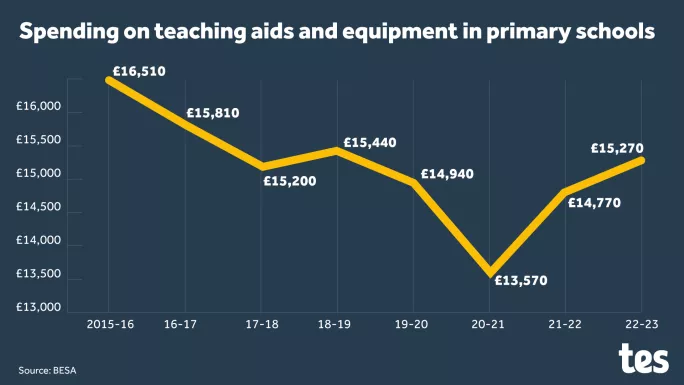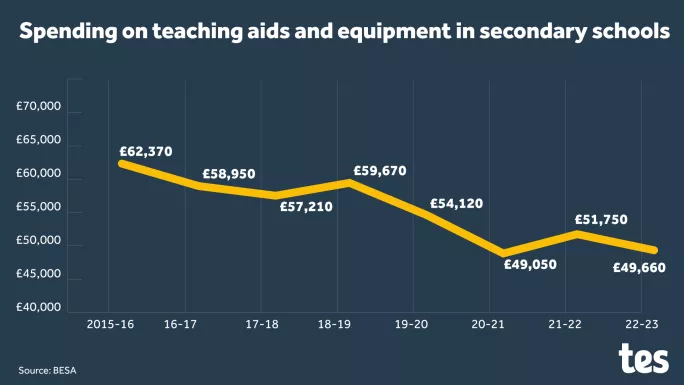Revealed: how school funding squeeze is hitting classroom resources

Spending on teaching aids and equipment is stuck below 2015-16 levels as schools face mounting financial pressures, according to data seen by Tes.
Spending on these resources will average £55 per primary school pupil and £49 per secondary school pupil in 2022-23 - around 25 per cent less than in 2015-16, data collected by the British Educational Suppliers Association (BESA) shows.
BESA director general Caroline Wright described the trend as “worrying”, while the Association of School and College Leaders says it reflects the “significant cutbacks” schools are having to make.
The figures come amid concerns from school leaders that a perfect storm of financial pressures will put a huge strain on school budgets this year - and that the quality of education and support for pupils will suffer.
- Budget 2021: Covid catch-up fund boosted by £1.8bn
- Long read: Schools are on the financial brink - and it’s going to get worse
- Related: Heads’ leader warns ministers a new funding crisis is ‘looming’
Spending on aids and equipment - which includes all classroom teaching and learning spending excluding ICT, furniture and stationery - had been rising in secondary schools up to 2018-19, but then saw a steep fall.
A subsequent uplift in 2021-22 is now set to be reversed in 2022-23, according to the BESA data, which comes from 752 primary schools and 452 secondaries.
Meanwhile, spending on teaching aids and equipment in primaries fell slightly in 2019-20 before rising in 2020-21. However, in 2022-23, it is still forecast to stay around 7 per cent lower than in 2015-16.

Overall, across primaries and secondaries, whole resource spending - including ICT, furniture, stationery, and teaching and learning resources - will decline by 3 per cent between 2021-22 and 22-23, BESA predicts.
Speaking as part of the Tes Magazine Education Insights Expert Panel (see below for more details), Ms Wright said schools needed resources to “inspire children”.
She said: “It’s a really worrying situation. We’ve all talked about the pressures on schools to support pupils.
“Obviously with teachers, you need a really safe and welcoming environment but you also need resources of some kind to be able to inspire the children. So that’s a big challenge.”
The BESA data shows an average forecast spend on resources of £15,270 per primary school in 2022-23, compared with £16,510 in 2015-16.
In secondaries, the figures were £49,660 and £62,370, respectively.

Responding to the findings, Hayley Dunn, business leadership specialist at the Association of School and College Leaders (ASCL), said school budgets had been under pressure for many years, leaving them with no choice other than to make significant cutbacks, and the exacerbation of the situation caused by rising energy bills could “partially” explain the resource spending levels.
She added: “The government must help relieve the financial pressure on schools and colleges by improving the level of funding they receive.”
‘Sensory’ resources prioritised
Ms Wright also said that generally, schools were moving back towards buying sensory and hands-on equipment, after an uptick in ICT spending during the pandemic.
She added: “What we saw throughout lockdown and moving back into schools was a huge uptick in terms of the use of digital resources.
“What we’re now seeing in primary schools, particularly, is a decline in the use of digital resources and a move back in terms of purchasing play equipment, hands-on sort of sensory equipment. The teachers know whether children have missed out on some of those really important social skills and they are adapting their own classrooms and schools effectively.”
She was speaking on a panel that also featured multi-academy trust leaders Cathie Paine from REAch2 and Rebecca Boomer-Clark from AET, as well as Professor Becky Francis, chief executive of the Education Endowment Foundation.
Coming out of the pandemic, projections from BESA data for 2021-22 suggest that ICT hardware and software spending will drop by 2 per cent in primaries, while spending on teaching aids and equipment will go up by 9 per cent.
Funding squeeze
A Department for Education spokesperson said: “We recognise schools may be facing cost pressures, and we are looking carefully at the impact on schools as well as considering what additional support we could offer.
“In 2022-23, core schools funding will increase by £4bn compared to 2021-22 - a 7 per cent cash real terms per pupil boost - and this will help schools to meet wider cost pressures.
“All schools can access a range of tools to help them get the best value from their resources, including recommended deals for energy costs and services related to energy.”
The Institute for Fiscal Studies is projecting that spending per pupil in 2024 will be at about the same level as in 2010, as it fell by 9 per cent in real terms between 2009-10 and 2019-20.
BESA’s data is based on self-reporting from schools based on their financial years. Maintained schools report for the period April to March and academies report on the period September to August.
All the data was collected in November and December last year.
The DfE has been contacted for comment.
Tes Magazine Education Insights is a new offering from Tes magazine that features a monthly in-depth report on the education sector alongside a webinar featuring leading figures from schools, education research and the commercial sector. You can download the first report and webinar for free here.
You need a Tes subscription to read this article
Subscribe now to read this article and get other subscriber-only content:
- Unlimited access to all Tes magazine content
- Exclusive subscriber-only stories
- Award-winning email newsletters
Already a subscriber? Log in
You need a subscription to read this article
Subscribe now to read this article and get other subscriber-only content, including:
- Unlimited access to all Tes magazine content
- Exclusive subscriber-only stories
- Award-winning email newsletters
topics in this article



